Hi all, while blinking through my lights of my lion nebula data Sh2-132 - The Lion Nebula ( kuechlew ) - AstroBin, I saw two "stars" appearing in one of my frames: 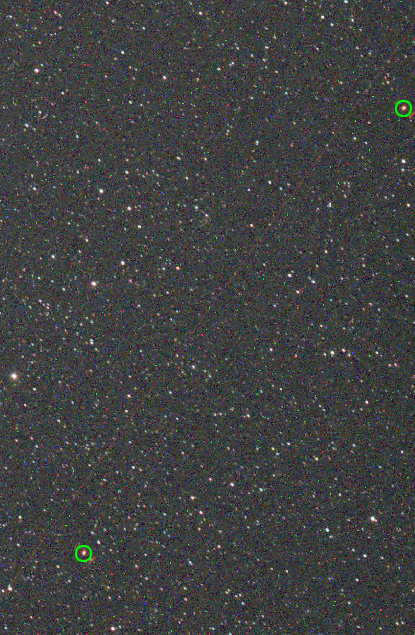 They are not visible in the frames before and after. A closer look reveals a faint "satellite trail" close by and at the same distance of both "stars". So it seems the light points are related to the "satellite". Image scale is around 4 arcseconds and distance between the light sources and the "satellite" trail is about 40 pixels (160 arcseconds). If my math doesn't let me down this relates to a 270 - 390m distance from the "satellite" for the usual 350 - 500 km satellite orbit height. I find it interesting that the light source is much brighter than the satellite itself. Any idea what this could be? Edit: exposure time is 180 seconds, so I would exclude a plane with position lights. This would lead to much more light points (and on either side of the plane ...). Clear skies Wolfgang
|
You cannot like this item. Reason: "ANONYMOUS".
You cannot remove your like from this item.
Editing a post is only allowed within 24 hours after creating it.
You cannot Like this post because the topic is closed.
Copy the URL below to share a direct link to this post.
This post cannot be edited using the classic forums editor.
To edit this post, please enable the "New forums experience" in your settings.
Hi Wolfgang, See what you mean. If you look closely it seems to me that each is also associated with a short red line on the opposite side (relative to the satellite trail) of the two green-circled bright spots which (based upon the image scale v height scale that you estimated) may be within 30m? I wonder if this is part of an array of identical satellites moving in synchrony and you just happened to have caught two of them with each having one part (solar panel?) more reflective ? However, if so they do seem to be moving too slowly ?/ impossibly high given so little angular movement in 3 min ? Tim PS Forgot that your scope is tracking so maybe geostationary satellites? cf https://skyandtelescope.org/observing/how-to-see-and-photograph-geosynchronous-satellites/PPS and had also forgot that the DEC of the Lion is about +55 deg! So maybe not GEOSAT -- or they are spy satellites in geosynch rather than equatorial orbits :-)
|
You cannot like this item. Reason: "ANONYMOUS".
You cannot remove your like from this item.
Editing a post is only allowed within 24 hours after creating it.
You cannot Like this post because the topic is closed.
Copy the URL below to share a direct link to this post.
This post cannot be edited using the classic forums editor.
To edit this post, please enable the "New forums experience" in your settings.
This might be very mundane, but what about a simple plane? They have blinking lights right? You can also see a faint red light spanning parallel to the lights across the frame.
|
You cannot like this item. Reason: "ANONYMOUS".
You cannot remove your like from this item.
Editing a post is only allowed within 24 hours after creating it.
You cannot Like this post because the topic is closed.
Copy the URL below to share a direct link to this post.
This post cannot be edited using the classic forums editor.
To edit this post, please enable the "New forums experience" in your settings.
Tim Hawkes:
Hi Wolfgang,
See what you mean. If you look closely it seems to me that each is also associated with a short red line on the opposite side (relative to the satellite trail) of the two green-circled bright spots which (based upon the image scale v height scale that you estimated) may be within 30m?
I wonder if this is part of an array of identical satellites moving in synchrony and you just happened to have caught two of them with each having one part (solar panel?) more reflective ? However, if so they do seem to be moving too slowly ?/ impossibly high given so little angular movement in 3 min ?
Tim
PS Forgot that your scope is tracking so maybe geostationary satellites?
cf https://skyandtelescope.org/observing/how-to-see-and-photograph-geosynchronous-satellites/
PPS and had also forgot that the DEC of the Lion is about +55 deg! So maybe not GEOSAT -- or they are spy satellites in geosynch rather than equatorial orbits :-) Hi Tim, well spotted indeed: 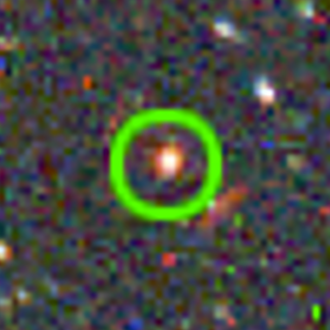 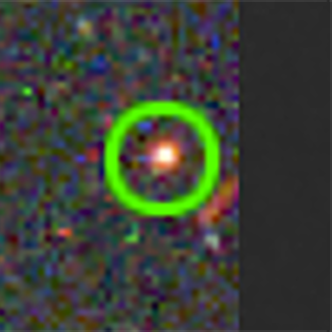 apologies for the unsharp 400% image but the red lines you spotted are hard to see even in the 100% view above. And yes, 22 - 32 m distance for the typical satellite height, so most likely some solar panel. I have to check the exact time and whether a solar reflection could be possible in this position at that time. Thank you for your support and clear skies! Wolfgang
|
You cannot like this item. Reason: "ANONYMOUS".
You cannot remove your like from this item.
Editing a post is only allowed within 24 hours after creating it.
You cannot Like this post because the topic is closed.
Copy the URL below to share a direct link to this post.
This post cannot be edited using the classic forums editor.
To edit this post, please enable the "New forums experience" in your settings.
Stefan Pfleger:
This might be very mundane, but what about a simple plane? They have blinking lights right? You can also see a faint red light spanning parallel to the lights across the frame. I have quite a bit of experience with planes in my images, they look differently. They blink at a high frequency. If they are flying high, you see much more than two light points. If they are flying low you see long streaks instead of light points due to the higher angular velocity. And usually you have lights both on the left and right side of the plane. A case in point: 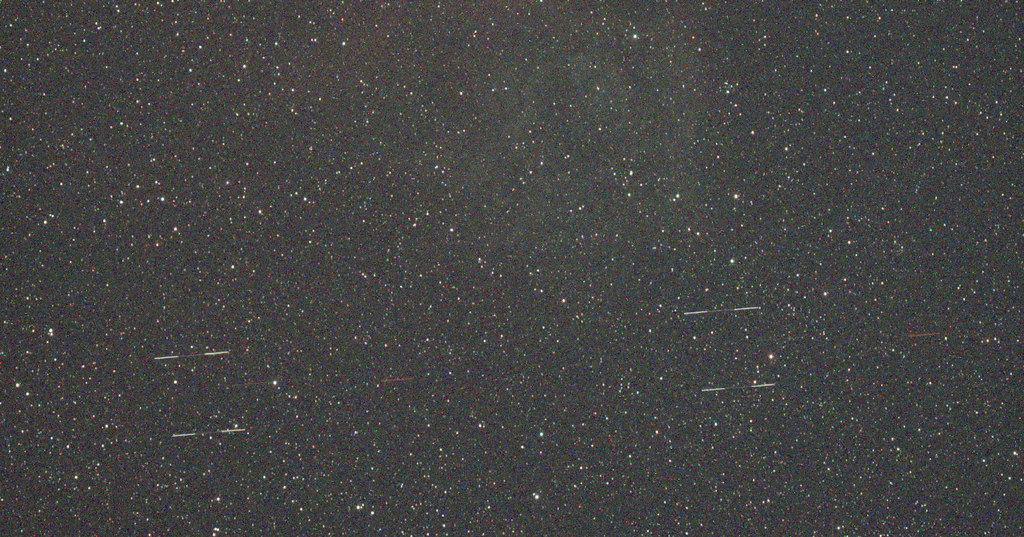 A fast, low flying plane with three (five?) lights, one red in the middle and the remaining white ones on the wings. Clear skies Wolfgang
|
You cannot like this item. Reason: "ANONYMOUS".
You cannot remove your like from this item.
Editing a post is only allowed within 24 hours after creating it.
You cannot Like this post because the topic is closed.
Copy the URL below to share a direct link to this post.
This post cannot be edited using the classic forums editor.
To edit this post, please enable the "New forums experience" in your settings.
Addendum: Very high flying planes look like this one (passing the coathanger): 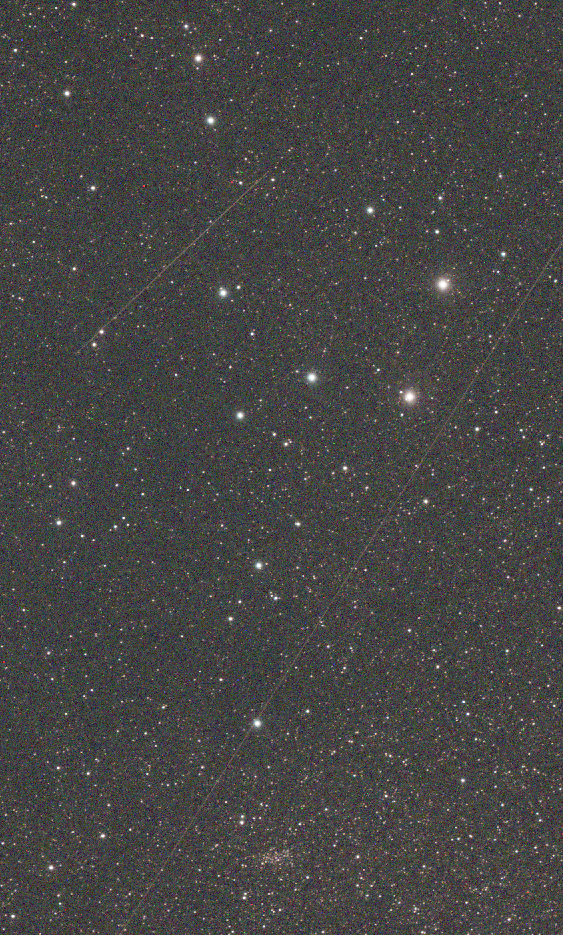 upper short streak is a high flying plane, lower long streak a satellite. Clear skies Wolfgang
|
You cannot like this item. Reason: "ANONYMOUS".
You cannot remove your like from this item.
Editing a post is only allowed within 24 hours after creating it.
You cannot Like this post because the topic is closed.
Copy the URL below to share a direct link to this post.
This post cannot be edited using the classic forums editor.
To edit this post, please enable the "New forums experience" in your settings.
Addendum: This is how a satellite trail looks like when the satellite (passing the north america nebula) picks up the sun: 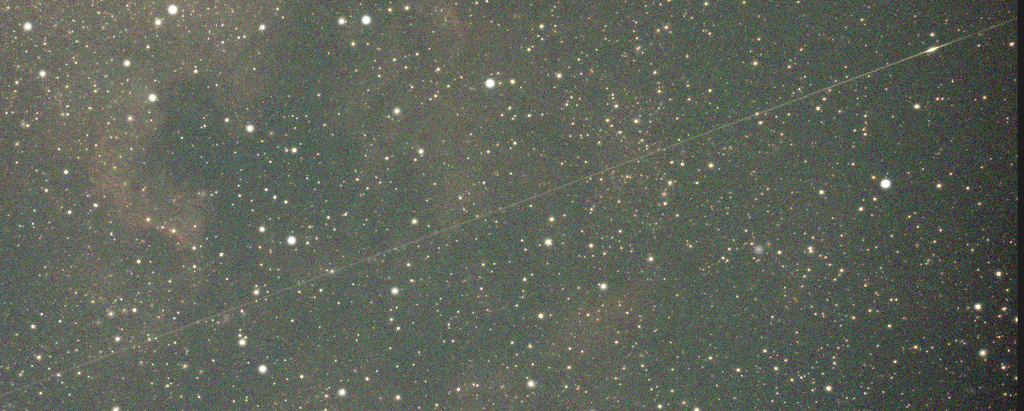 Clear skies Wolfgang
|
You cannot like this item. Reason: "ANONYMOUS".
You cannot remove your like from this item.
Editing a post is only allowed within 24 hours after creating it.
You cannot Like this post because the topic is closed.
Copy the URL below to share a direct link to this post.
This post cannot be edited using the classic forums editor.
To edit this post, please enable the "New forums experience" in your settings.
Here is what a Federation X-Wing Fighter looks like passing through a frame 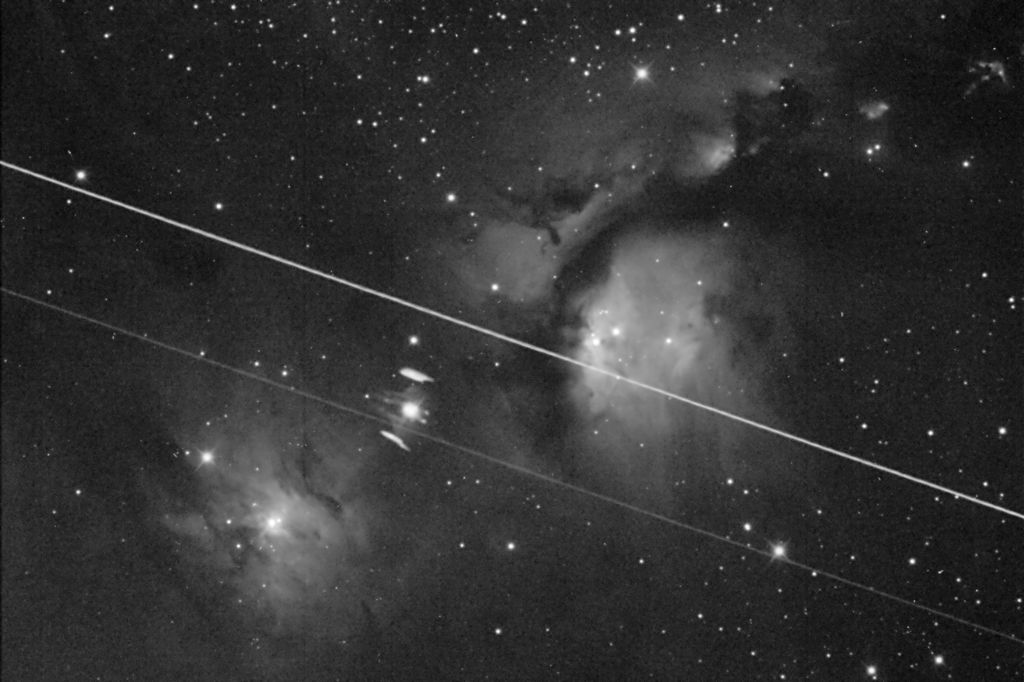 |
You cannot like this item. Reason: "ANONYMOUS".
You cannot remove your like from this item.
Editing a post is only allowed within 24 hours after creating it.
You cannot Like this post because the topic is closed.
Copy the URL below to share a direct link to this post.
This post cannot be edited using the classic forums editor.
To edit this post, please enable the "New forums experience" in your settings.
This is clearly the becon light pattern of an airplane. I had several of them on my subs. In addition you can see the red position light on the wing edge.
|
You cannot like this item. Reason: "ANONYMOUS".
You cannot remove your like from this item.
Editing a post is only allowed within 24 hours after creating it.
You cannot Like this post because the topic is closed.
Copy the URL below to share a direct link to this post.
This post cannot be edited using the classic forums editor.
To edit this post, please enable the "New forums experience" in your settings.
Christoph Lichtblau:
This is clearly the becon light pattern of an airplane. I had several of them on my subs. In addition you can see the red position light on the wing edge Does this refer to the original picture or the X wing fighter which looks pretty nailed on to me? Tim
|
You cannot like this item. Reason: "ANONYMOUS".
You cannot remove your like from this item.
Editing a post is only allowed within 24 hours after creating it.
You cannot Like this post because the topic is closed.
Copy the URL below to share a direct link to this post.
This post cannot be edited using the classic forums editor.
To edit this post, please enable the "New forums experience" in your settings.
Christoph Lichtblau:
This is clearly the becon light pattern of an airplane. I had several of them on my subs. In addition you can see the red position light on the wing edge. you do mean the first post right? I also think an airplane but i sense the easy answer would be aliens  |
You cannot like this item. Reason: "ANONYMOUS".
You cannot remove your like from this item.
Editing a post is only allowed within 24 hours after creating it.
You cannot Like this post because the topic is closed.
Copy the URL below to share a direct link to this post.
This post cannot be edited using the classic forums editor.
To edit this post, please enable the "New forums experience" in your settings.
I don't think at all that it's aliens. But what still puzzles me about the airplane suggestion:
How do you explain that the image of the light source is point-like? For a point like image the airplane has to fly at a low angular velocity (i.e. reasonably high in the sky). But if this is the case, then why are there only two light points in a 3 minute sub? The overall angle of the path of the light source spans about 1.4 degrees, these 1.4 degrees are passed with only two "flashes". As I already pointed out I see a lot of planes in my images in each session. I so far never had a pattern like this one and I find it hard to corelate the image with the high frequency of a beacon light. In addition, there remains the question why do we see the beacon light but not the mandatory position lights on the tips of the wings left and right of it? Admittedly, at some height of the plane these lights merge into one but at that point you just get a light trail as depicted in the coathanger image above.
I'm happy to believe the airplane hypothesis if someone can answer these questions convincingly.
|
You cannot like this item. Reason: "ANONYMOUS".
You cannot remove your like from this item.
Editing a post is only allowed within 24 hours after creating it.
You cannot Like this post because the topic is closed.
Copy the URL below to share a direct link to this post.
This post cannot be edited using the classic forums editor.
To edit this post, please enable the "New forums experience" in your settings.
why are there only two light points in a 3 minute sub? One answer would be that the plane was flying much lower than you think and passed through in a fraction of the 180 second exposure duration. That might suggest a light aircraft or more probably a drone which wouldn't have port/starboard wingtip lights? LED strobes when pulsed can be very short duration, hence the point source rather than a streak. Michael
|
You cannot like this item. Reason: "ANONYMOUS".
You cannot remove your like from this item.
Editing a post is only allowed within 24 hours after creating it.
You cannot Like this post because the topic is closed.
Copy the URL below to share a direct link to this post.
This post cannot be edited using the classic forums editor.
To edit this post, please enable the "New forums experience" in your settings.









